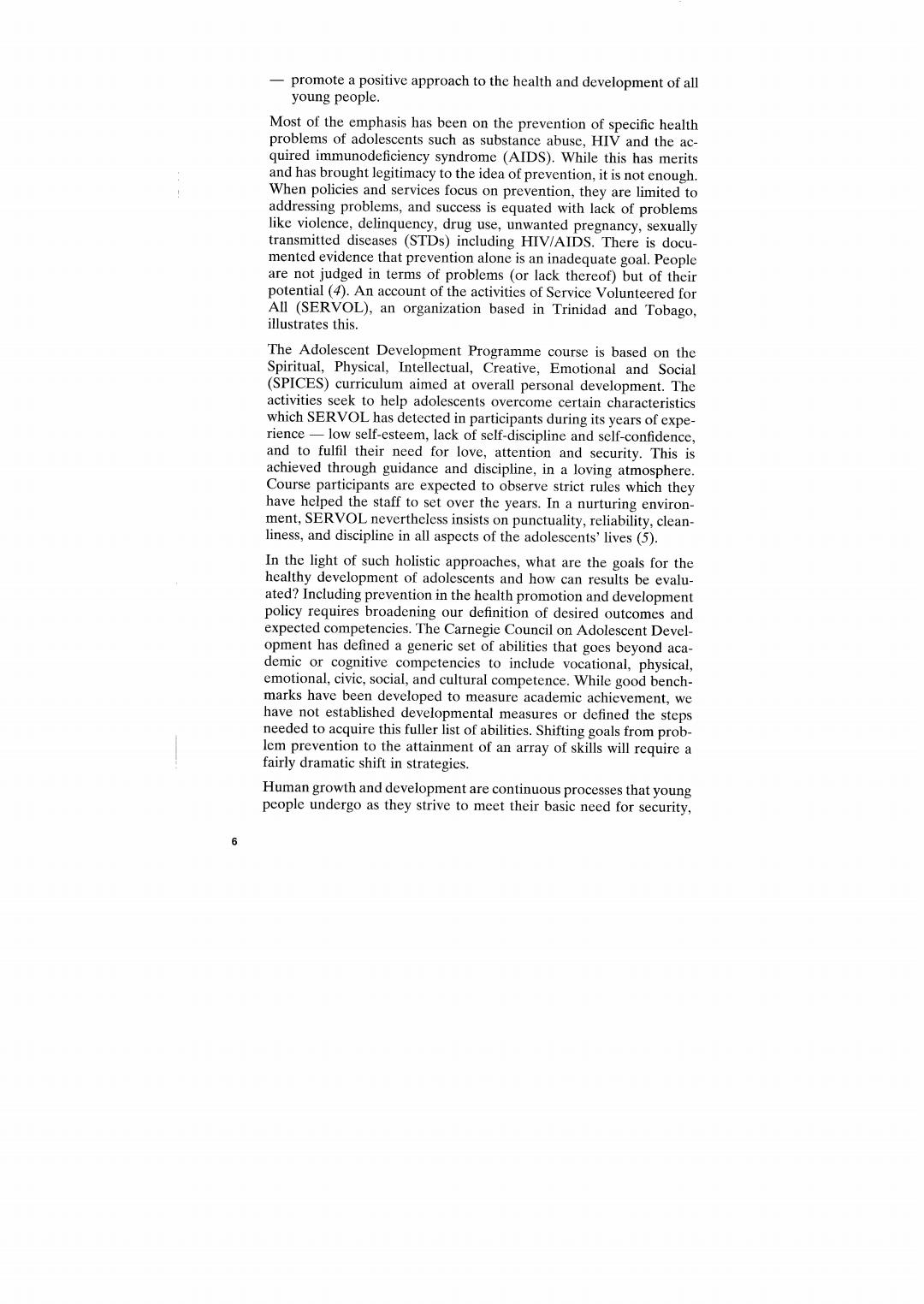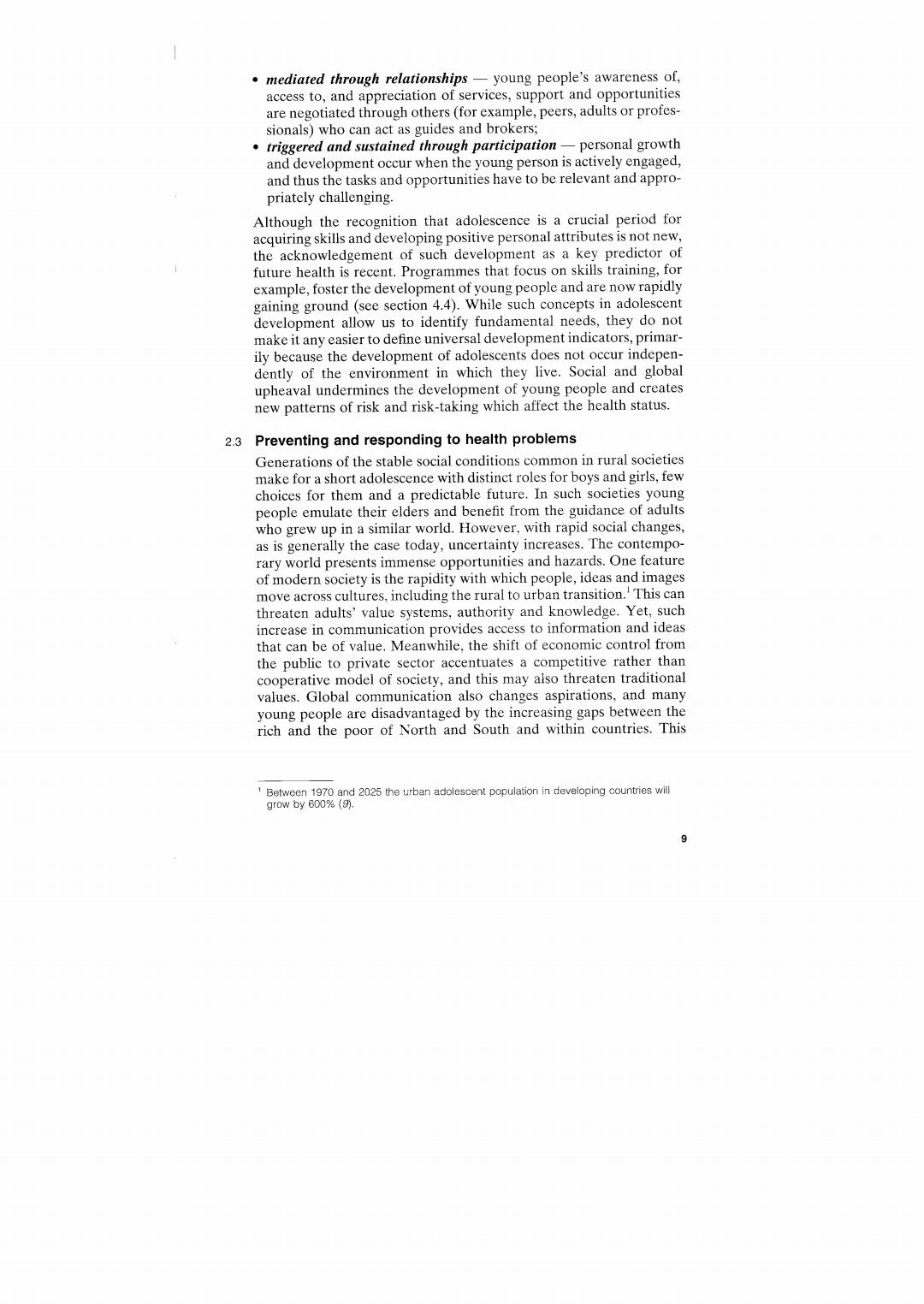
-promote a positive approach to the health and development of all young people. Most of the emphasis has been on the prevention of specific health problems of adolescents such as substance abuse,HIV and the ac- quired immunodeficiency syndrome(AIDS).While this has merits and has brought legitimacy to the idea of prevention,it is not enough When policies and services focus on prevention,they are limited to addressing problems,and success is equated with lack of problems like violence,delinquency,drug use,unwanted pregnancy,sexually transmitted diseases (STDs)including HIV/AIDS.There is docu- mented evidence that prevention alone is an inadequate goal.People are not judged in terms of problems (or lack thereof)but of their potential (4).An account of the activities of Service Volunteered for All (SERVOL),an organization based in Trinidad and Tobago, illustrates this. The Adolescent Development Programme course is based on the Spiritual,Physical,Intellectual,Creative,Emotional and Social (SPICES)curriculum aimed at overall personal development.The activities seek to help adolescents overcome certain characteristics which SERVOL has detected in participants during its years of expe- rience-low self-esteem,lack of self-discipline and self-confidence and to fulfil their need for love,attention and security.This is achieved through guidance and discipline,in a loving atmosphere Course participants are expected to observe strict rules which they have helped the staff to set over the years.In a nurturing environ- ment,SERVOL nevertheless insists on punctuality,reliability,clean- liness,and discipline in all aspects of the adolescents'lives (5). In the light of such holistic approaches,what are the goals for the healthy development of adolescents and how can results be evalu- ated?Including prevention in the health promotion and development policy requires broadening our definition of desired outcomes and expected competencies.The Carnegie Council on Adolescent Devel- opment has defined a generic set of abilities that goes beyond aca- demic or cognitive competencies to include vocational,physical emotional,civic,social,and cultural competence.While good bench- marks have been developed to measure academic achievement,we have not established developmental measures or defined the steps needed to acquire this fuller list of abilities.Shifting goals from prob- lem prevention to the attainment of an array of skills will require a fairly dramatic shift in strategies. Human growth and development are continuous processes that young people undergo as they strive to meet their basic need for security

love and appreciation and to feel valued and useful.The processes. articulated as outcomes of adolescent development (6),can be sum- marized as follows: self-worth-the ability to contribute and to perceive one's contri- bution as meaningful;the perception that one is a "good person' and that one is valued by oneself and others; safety and structure -the perception that one is safe both physically and psychologically,in other words,access to adequate food,clothing,shelter,and security,including protection from hurt,injury,or loss.The existence of organized group structures in life can allow young people the freedom to experiment with behaviour and to test their social abilities,while providing limits; belonging and membership-being a participating member of a community;involved in at least one lasting relationship with an- other person;the perception that one is strongly attached to an institution,organization or communitv outside of family; intimate relationship-the perception that one is loved by kin, and fully appreciated by friends; .mastery and future-the perception that one is accomplished and has abilities valued by oneself and others;awareness of one's progress in life: responsibility and autonomy-the perception that one has some control over daily events;one is a unique person with a past present and future and roles to play; spirituality-connectedness to principles concerning families,cul- tural groups,communities and gods:an awareness of one's own personality or individuality. To achieve these outcomes,young people should attempt to build the skills that will allow them to function within.and contribute to,the communities and societies in which they live.The goals of this process can be categorized as follows: physical health and development-using the knowledge,desire. and ability to develop and maintain a healthy and fulfilling lifestyle; acting in ways that best ensure current and future physical health, for oneself and others; intellectual development-learning in school and other settings to gain basic knowledge,numeracy,literacy;using critical thinking, creative problem-solving and expressive skills and conducting independent study; vocational health and employability-the mastery of skills and attitudes to identify opportunities for economic security,including

management of time and money.and dealing with other people in commercial relationships:understanding career options and the steps necessary to reach goals: civic and social health-collaborating with others for the greater good:the knowledge,motivation and ability to form and sustain friendships and relationships through communication,cooperation, empathizing,negotiation,patience;and taking initiative and re- sponsibility for one's own conduct: cultural health-understanding and respecting one's culture; emotional health-acquiring the knowledge and ability to de- velop and maintain a personal sense of well-being;and understand- ing one's own emotions and adapting to changing situations; moral development-understanding and acting upon the distinc- tions between right and wrong. The attainment of such goals is a natural part of adolescence.Verbal and numerical skills,and abstract thinking are expanded in school for those who attend,while most young people acquire new vocational and recreational skills.Of crucial importance for health,however,are the social skills needed for the new kinds of relationships formed during adolescence.Personal communication skills and the ability to assert thoughts,ideas,feelings and beliefs are essential.These are some of the key“life skills”defined by WHO(7)as“abilities for adaptive and positive behaviour,that enable individuals to deal effec- tively with the demands and challenges of everyday life" There are six key aspects of the overall development process(8), namely: ongoing-it does not end with the termination of programmes and requires continuous input and support; uneven-it varies enormously both within and between indi viduals: compler-individual development is a process of physical,cogni- tive,social,emotional,and moral maturation;the associated tasks during adolescence are:to reach adult size,and develop comfort with adult functioning;to develop the ability for abstract thinking; the skills and perspectives to function independently of family and peer group;a sense of identity that can guide choices and help to process feelings;and basic values and perspectives that allow the individual to be ethical,just and compassionate; influenced by the environment-whether this is described in terms of physical attributes (safety or availability of essential facilities,for example)or in terms of the quality,quantity,and congruence of key services,supports and opportunities;

mediated through relationships-young people's awareness of, access to,and appreciation of services,support and opportunities are negotiated through others(for example,peers,adults or profes- sionals)who can act as guides and brokers; triggered and sustained through participation-personal growth and development occur when the young person is actively engaged, and thus the tasks and opportunities have to be relevant and appro- priately challenging. Although the recognition that adolescence is a crucial period for acquiring skills and developing positive personal attributes is not new, the acknowledgement of such development as a key predictor of future health is recent.Programmes that focus on skills training,for example,foster the development of young people and are now rapidly gaining ground (see section 4.4).While such concepts in adolescent development allow us to identify fundamental needs,they do not make it any easier to define universal development indicators,primar- ily because the development of adolescents does not occur indepen- dently of the environment in which they live.Social and global upheaval undermines the development of young people and creates new patterns of risk and risk-taking which affect the health status. 2.3 Preventing and responding to health problems Generations of the stable social conditions common in rural societies make for a short adolescence with distinct roles for boys and girls,few choices for them and a predictable future.In such societies young people emulate their elders and benefit from the guidance of adults who grew up in a similar world.However,with rapid social changes, as is generally the case today,uncertainty increases.The contempo- rary world presents immense opportunities and hazards.One feature of modern society is the rapidity with which people,ideas and images move across cultures,including the rural to urban transition.'This can threaten adults'value systems,authority and knowledge.Yet,such increase in communication provides access to information and ideas that can be of value.Meanwhile,the shift of economic control from the public to private sector accentuates a competitive rather than cooperative model of society,and this may also threaten traditional values.Global communication also changes aspirations,and many young people are disadvantaged by the increasing gaps between the rich and the poor of North and South and within countries.This Between 1970 and 2025 the urban adolescent population in developing countries will grow by 600%(9). 9

situation is aggravated by rapid population growth in countries least equipped to meet the new challenges. Such upheaval is accompanied by changing trends in adolescent behaviour and consequently in health status.While new technology and improved standards of living in many societies offer potential for the development of young people,other changes increase the risks to their health,often by influencing their behaviour.Decreasing family influence,earlier puberty and later marriage extend the risks of un- protected sex among unmarried adolescents in some parts of the world.In others a large proportion of first marriages and first births continue to occur among adolescent women.Rapid urbanization, widespread telecommunications,greater access to (and pressure to use)potentially harmful substances,and increased travel,tourism, migration,refugee populations and homelessness are changing society,but their effects on the behaviour of young people remain unpredictable.Inequity between the sexes makes adolescent girls particularly vulnerable to problems arising from these changing conditions. On the basis of mortality rates alone,adolescence was previously considered one of the healthiest periods in human life.However, there is growing recognition of the wide-ranging health problems faced by adolescents because of a combination of biological,psycho- logical and social factors.Table 1 illustrates the global magnitude of a wide range of health problems that frequently combine to severely limit healthy development.For each broad category,it is possible to identify not only specific behavioural risks(to which the concept of "risk-taking"applies)but also risks which arise simply as a result of the young person being in a particular environment.Risk is therefore not restricted to behaviour.Measures aimed at reducing both types of risk can significantly lower the current high rates of associated mortal- ity and morbidity. Concerning the nature and scope of these problems,their effects on adolescents and the way to manage them,several points deserve mention: Certain health problems are more prevalent in adolescents than in children or adults.These include health problems resulting from early,unprotected and unwanted sexual activity;substance use and abuse;injuries from accidents and violence;health problems asso- ciated with overnutrition and undernutrition;and some endemic diseases.Some of these health problems are closely interrelated (such as multiple drug use and depressive states;alcohol use and injuries from traffic accidents;undernutrition and complications in 10